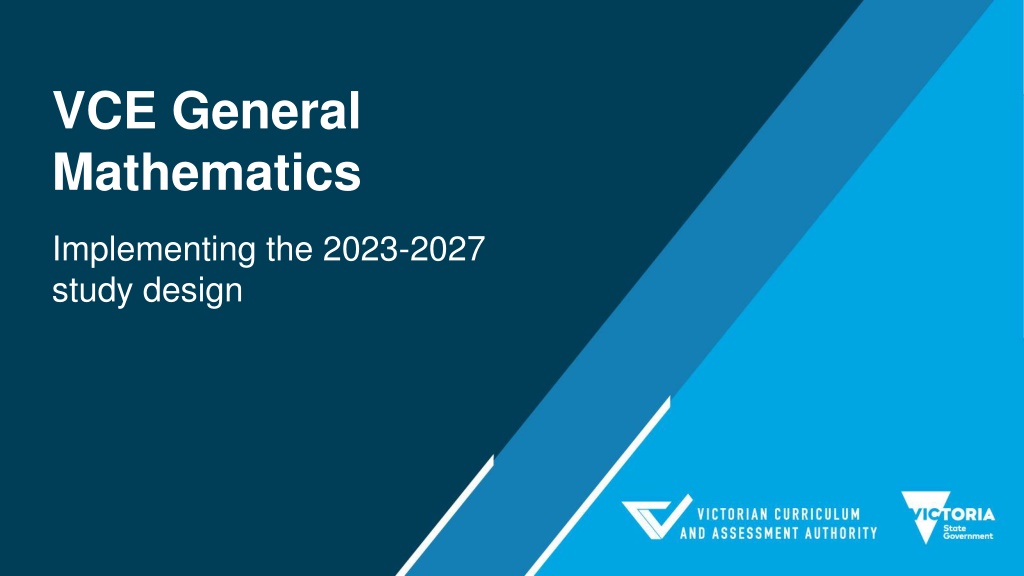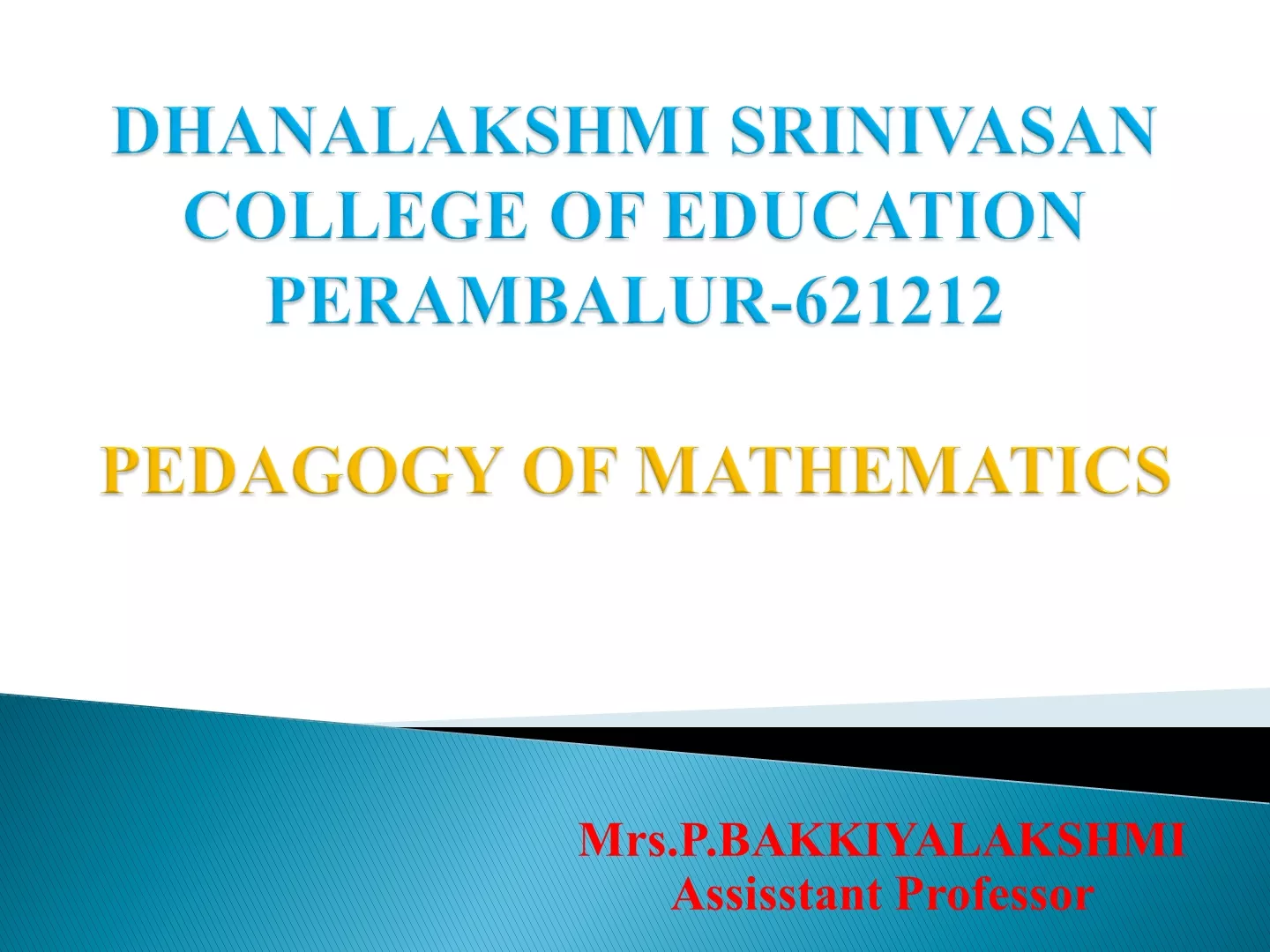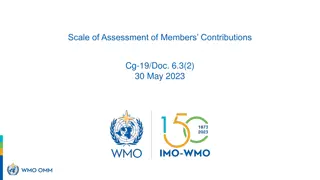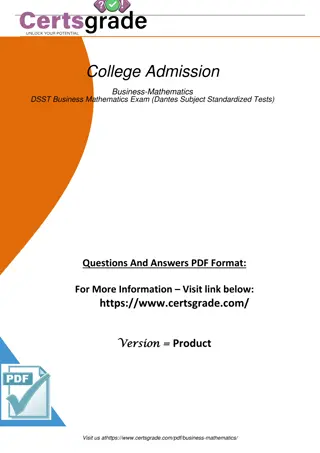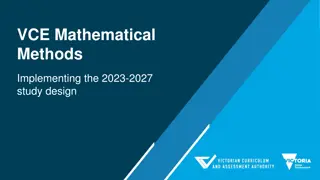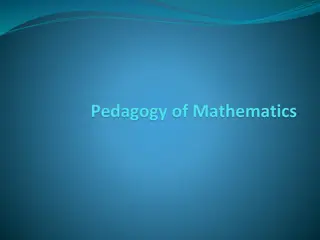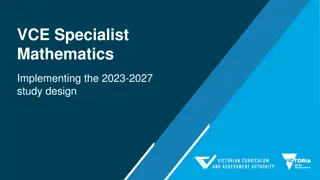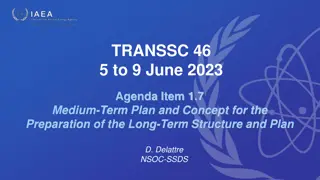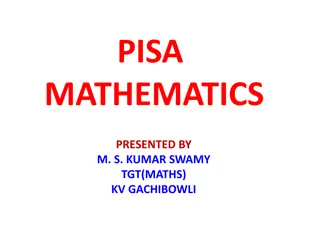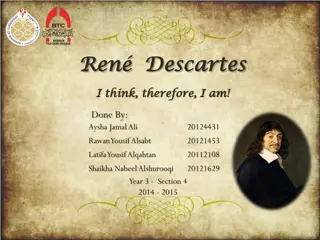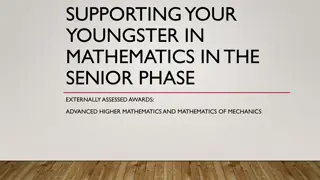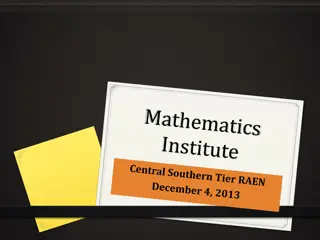General Mathematics Study Design 2023-2027 Overview
The General Mathematics Study Design for 2023-2027 includes prescribed content for Units 1 and 2, covering areas such as data analysis, probability, algebra, functions, discrete mathematics, and more. The study design aims to provide a structured framework for students in understanding mathematical concepts and applications, leading to a comprehensive understanding of General Mathematics. With a focus on developing essential skills and knowledge, this study design sets the foundation for higher-level mathematical studies.
Download Presentation

Please find below an Image/Link to download the presentation.
The content on the website is provided AS IS for your information and personal use only. It may not be sold, licensed, or shared on other websites without obtaining consent from the author.If you encounter any issues during the download, it is possible that the publisher has removed the file from their server.
You are allowed to download the files provided on this website for personal or commercial use, subject to the condition that they are used lawfully. All files are the property of their respective owners.
The content on the website is provided AS IS for your information and personal use only. It may not be sold, licensed, or shared on other websites without obtaining consent from the author.
E N D
Presentation Transcript
VCE General Mathematics Implementing the 2023-2027 study design
General Outline 1. Brief background and new structure of Mathematics 2023-2027 2. Outline of General Mathematics Units 1 4 revisions 3. Discuss Investigations for Unit 1&2 leading to SACs in Unit 3&4 4. Address some FAQs (If time runs out, my contact details will be supplied)
The Study Design 2023-2027 Result of a thorough consultation and review process Published in February 2022 VRQA accredited from 2023 until 2027 VCAA undertake ongoing monitoring of study design implementation over the life of the study design VCAA support the implementation of the study design through an implementation program that includes webinars, on-demand videos, support materials and resources that provide guidance around study design awareness and clarification, sample course structures, suggested learning activities and sample investigations
VCE Mathematics studies 2023 - 2027 From 2023 there are four completely prescribed Units 1 4 VCE Mathematics studies: General Mathematics Mathematical Methods General Mathematics Specialist Mathematics In each sequence, Units 1 and 2 contain assumed knowledge and skills for Units 3 and 4. Mathematical Methods Units 1 and 2 also contain assumed knowledge and skills for Specialist Mathematics Units 3 and 4. General Mathematics Units 3 and 4 assumes the previous completion of General Mathematics Units 1 and 2.
General Mathematics Units 1 The 2023 2027 General Mathematics study design prescribes the content for each of Unit 1&2. Areas of study in Unit 1 Data analysis, probability and statistics Algebra, number and structure Functions, relations and graphs Discrete mathematics
General Mathematics Units 2 The 2023 2027 General Mathematics study design prescribes the content for each of Unit 1&2. Areas of study in Unit 2 Data analysis, probability and statistics Discrete mathematics Functions, relations and graphs Space and measurement
General Mathematics Unit 1 Revised: U1_AOS1: Topic: Investigating and comparing data distributions Types of data (interval and ratio) Consideration of a range of distributions, summary statistics emphasising spread U1_AOS2: Algebra, number and structure Brief introduction to sequences Detailed link between sequences and first-order linear recurrence relations Exploration of practical situations involving recurrence relations including strong links to financial applications,
General Mathematics Unit 1 Revised: U1_AOS3: Functions, relations and graphs Focussed exploration of linear functions and their different forms Practical applications of linear functions and their solutions- U1_AOS4: Matrices Introduction to transition matrices including long run trends and steady state
General Mathematics Unit 2 modified: U2_AOS1: Data analysis, probability and statistics Informal interpretation of association and causation No longer a requirement for Pearson correlation coefficient Line of good fit by eye to make predictions No longer a requirement for least squares line U2_AOS2: Discrete mathematics Broader definition of greedy algorithms
General Mathematics Unit 2 Modified/Added: U2_AOS3: Functions, Relations and Graphs Transformation to linearity includes y and log10(x) Modelling of non-linear data now only utilizes k x = , 0 y k U2_AOS4: Space and Measurement Broader definitions for notions of similarity and 3-D applications for Pythagoras theorem Arcs and sectors specified for circles; Elementary trigonometry notions combined Area of a triangle and Heron s formula now present in the KK and KS only
General Mathematics Unit 1&2 Rewritten/removed/deleted: U1_AOS1: algebra and structure Linear relations and equations significant re-write, greater clarification (2-var SE still in) AOS5: Graphs of linear and non-linear relations Linear graphs and models Inequalities and linear programming Joint variation AOS6: Statistics Pearson s correlation coefficient
General Mathematics Units 3 & 4 Areas of Study: AoS1: Data analysis, Probability and statistics Data analysis AoS2: Discrete mathematics Recursion and financial modelling Matrices and their applications Networks and decision mathematics NO MODULES General Mathematics is now a fully prescribed study
Previous vs New Structure 2022 Further Maths 3&4 2023 2027 General Maths 3&4 AoS1 CORE: Data analysis AND Recursion and financial modelling AoS1 Data Analysis, Probability and Statistics: Investigating data distributions Investigating association between two variables Investigating modelling linear associations Investigating and modelling time series Module 1 Matrices Module 2 Networks and decision mathematics AoS2 Discrete mathematics: Recursion and financial modelling Depreciation of assets Compound interest investments and loans Reducing balance loans Annuities and perpetuities Compound interest investment with periodic and equal additions to the principal Matrices Matrices and their applications Transition matrices Networks and decision mathematics Graphs and networks Exploring travelling problems Trees and minimum connector problems Flow problems Shortest path problems Matching problems Scheduling problems and critical path analysis Module 3 Geometry and measurement Module 4 Graphs & relations
General Mathematics Units 3 & 4 The 2023 2027 General Mathematics study design is fully prescribed and combines the content for Unit 3&4. Areas of study in Unit 3 and 4 AOS1_Data analysis, probability and statistics Topic: Data analysis Investigating data distributions Investigating association between two variables Investigating and modelling linear associations Investigating and modelling time series data
General Mathematics Units 3 & 4 The 2023 2027 General Mathematics study design is fully prescribed and combines the content for Unit 3&4. Areas of study in Unit 3 and 4 AOS2_Discrete Mathematics Topic: Recursion and financial modelling Depreciation of assets Compound interest investments and loans Reducing balance loans Annuities and perpetuities Compound interest investment with periodic and equal additions to the principal
General Mathematics Units 3 & 4 The 2023 2027 General Mathematics study design is fully prescribed and combines the content for Unit 3&4. Areas of study in Unit 3 and 4 AOS2_Discrete Mathematics Topic: Matrices Matrices and their applications Transition matrices
General Mathematics Units 3 & 4 The 2023 2027 General Mathematics study design is fully prescribed and combines the content for Unit 3&4. Areas of study in Unit 3 and 4 AOS2_Discrete Mathematics Topic: Networks and decision mathematics Graphs and networks Exploring travelling problems Trees and minimum connector problems Scheduling problems and critical path analysis Flow problems Shortest path problems Matching problems
General Mathematics Units 3 & 4 New: AOS2: Discrete mathematics Matrices: Leslie matrices Outcome 3: Key knowledge The role of computational thinking in problem-solving and its application to mathematical investigations Reworded/modified: AOS1: Data analysis, probability and statistics Investigating and modelling linear associations: explicit description of logarithmic (base 10) AOS2: Discrete Mathematics Recursion and financial modelling: recurrence relation periods for an initial sequence from first principles
General Mathematics Units 3 & 4 Removed/deleted/modulated: AOS1: Data analysis Population and sample, random numbers and their use to draw simple random samples and the difference between population parameters and sample statistics Non-causal explanations for an observed association including common response, confounding and coincidence. AOS2: Recursion and financial modelling Concept and use of a first-order linear recurrence relation and its use in generating terms of a sequence (clarification of forms and application to financial modelling provided) AOS2: Matrices Use of matrices to represent systems of linear equations and the solutions of these equations. Concepts of dependent and inconsistent systems of equations in the context of solving pairs of simultaneous equations.
General Mathematics Units 3 & 4 In Unit 3&4, the assessment weighting used to calculate the final study score has weighted more towards the School-assessed Coursework (p. 11 in 2023-2027 study design) General Mathematics Assessment Unit 3 School-assessed Coursework: 24 per cent Unit 4 School-assessed Coursework: 16 per cent Units 3 and 4 Examination 1: 30 per cent Units 3 and 4 Examination 2: 30 per cent
Mathematical Investigation Units 1 & 2 For each unit: This comprises one to two weeks of investigation into one or two practical or theoretical contexts or scenarios based on content from areas of study and application of key knowledge and key skills for the outcomes. Investigation is to be incorporated in the development of concepts, skills and processes for the unit, and can be used to assess the outcomes.
Mathematical Investigation Units 1 & 2 There are three components to mathematical investigation: Formulation: overview of the context or scenario, and related background, including historical or contemporary background as applicable, and the mathematisation of questions, conjectures, hypotheses, issues or problems of interest. Exploration: investigation and analysis of the context or scenario with respect to the questions of interest, conjectures or hypotheses, using mathematical concepts, skills and processes, including the use of technology and application of computational thinking. Communication: summary, presentation and interpretation of the findings from the mathematical investigation and related applications.
Mathematical Investigation Units 1 & 2 Can be implemented in a variety of ways to meet requirements: as an investigative learning activity or activities as an assessment task or tasks a combination of the above Time range 1 to 2 weeks: Minimum one longer activity/task, or two shorter activities/tasks over the equivalent of 1 week duration Up to 2 weeks, a suitable combination, for example, two longer activities/tasks, one longer and two shorter activities tasks, three medium activities/tasks, four shorter activities/tasks
Mathematical Investigation Units 1 & 2 provides a natural and effective context for addressing Outcome 2 and Outcome 3 can be used to support computational thinking and experimentation is one of the assessment task types listed for Units 1 and 2 provides preparation for the investigation tasks in General Mathematics Units 3 and 4.
Sample Investigation topic Planning and costing for a day trip. Formulation: Planning and costing for a day trip including route planning costing using public transport. Explore locations and modes of transport. Exploration: Devise a costing plan for the day including key times, travel times ands costings. Alternative itineraries could be incorporated in case of unforeseen delays. Communication: Findings communicated in the form of a detailed itinerary incorporating a map and the costings.
SACs in Units 3 & 4 Application tasks Outcomes Outcome 1 Define and explain key concepts as specified in the content from the areas of study and apply a range of related mathematical routines and procedures. Outcome 2 Apply mathematical processes in non-routine practical contexts, including situations with some open- ended aspects requiring investigative, modelling or problem-solving techniques or approaches, and analyse and discuss these applications of mathematics. Outcome 3 Apply computational thinking and use numerical, graphical, symbolic and statistical functionalities of technology to develop mathematical ideas, produce results and carry out analysis in practical situations requiring investigative, modelling or problem-solving techniques or approaches. Marks allocated 10 20 10 40 Total marks
SACs in Units 3 & 4 - Investigation Introduction Immunisation is a key aspect of public health policy for the control of disease around the world. In particular data on immunisation rates is an important part of analysis. In this task we investigate the percentage of children aged 12-23 months immunized against the disease of measles (see:https://www.health.gov.au/funnelback/search?query=measles) in various countries. Relevant data can be found at: http://databank.worldbank.org/data/reports.aspx?source=2&series=SH.IMM.MEAS&country Component 1 Compare the distribution of immunisation rates in 1990 with those in 2015 for a group of countries. Randomly select 30 countries from the dataset. a. Construct an appropriate display to compare the immunisation rates for these countries in 1990 and 2015. b. Compare the distribution of immunisation rates for these countries in terms of shape, centre, spread and outliers. .
Computational Thinking Decomposition Break down the problem into simpler, less complex components Pattern Recognition Classify patterns in data and organizing data logically Representation and interpretation Abstraction Removing non essential information and focusing on principal structure only Algorithms A sequence of instructions that can be performed Link is HERE.
Some FAQs Will Support material be available and when? Will sample SACs be published by VCAA? Will pseudocode be examinable in General Mathematics? What does the SAC structure (effectively) look like? What is the role of computational thinking in General Mathematics?
Contact Michael MacNeill Curriculum Manager, Mathematics Victorian Curriculum and Assessment Authority Level 7, 2 Lonsdale Street, Melbourne 3000, Victoria T +61 3 7022 5538 M 0438 602 765 Email: Michael.MacNeill@education.vic.gov.au
